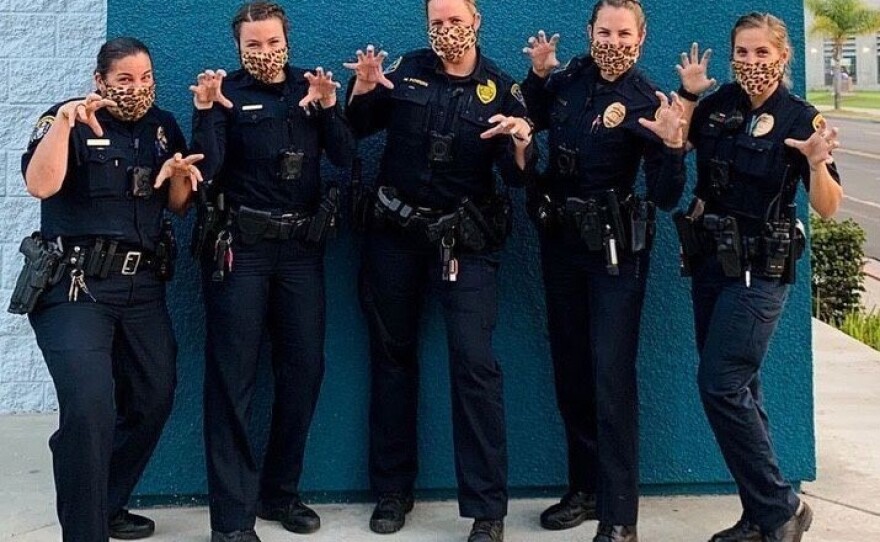The San Diego Police Department is paying an outside consultant $4,000 a month to help it seem more human and relatable on its social media accounts, including Twitter, Instagram, TikTok and Facebook, according to the department.
It's part of a targeted effort to change the department's tone on social media by posting frequent videos and short blurbs that show police officers doing good work or helping people, said Lt. Matt Botkin.
"The main reason for putting out these lighthearted, humanizing posts is to let people know not it's not just cops and robbers. We're not just here to put you in jail, we're caring for family members, helping people out," he said.
Up until recently, Botkin led the team of three officers who work on social media. He said their main focus is to go out and film videos of officers in the community doing good work, but they also spend time on other duties, such as answering questions from reporters.
The department started working with a consultant, Cole Pro Media, which offers what it calls "transparency engagement advising services" in March 2019 and began changing its tone on social media in the summer of 2019. Now, it's clear a change has taken place.
In the month of November, San Diego Police posted 70 times on Twitter, and less than half of those posts were public service announcements about things such as missing people, traffic alerts, or SWAT standoffs.
The rest were "slice of life" posts from the department, pictures of police cars from the 1980s, or talking about positive things police had done, such as buying food for people with their own money or quoting the lyrics to "Lean on Me" while describing officers helping a man whose car ran out of gas.
"Having a little down time, the officers drove him to get gas and even paid for it!" the post said.
Catherine Méndonca, an advocate with the organization United Against Police Terror San Diego, which films police officers on the job, said that's a waste of money and amounts to propaganda.
"They get so much of our city budget already from our tax dollars, for them to have to hire a consultant to train them on how to behave, says a lot about their policy," she said.
While filming police in her City Heights neighborhood, Mendonca said she doesn't often see police helping people.
"We see a lot of instances where officers would slander detainees, their demeanor and what their purpose is on the call is a lot different than what they want to portray themselves on social media," she said.
Some police posts also include detailed descriptions of incidents where someone was armed with a weapon but officers used de-escalation tactics and didn't shoot. This is intentional, Botkin said.
"It's unfair for us as an agency to think people will understand why we do what we do and the rationale behind it, if we don't take the time to explain the 'why' behind our actions," he said. "If they see us using a Taser, or a K9 police dog, that looks terrible. When there's a gap in information, that gets filled with facts, reason, context, or fear. Our goal is to fill it with facts and context to allow the viewers the opportunity to reach their own conclusions."
RELATED: Police Are Now Required To Release The Video When An Officer Shoots, But Not All Of It
San Diego Police pay the same consultant $5,000 to make a video any time an officer shoots someone—releasing this video is required by law. Botkin said many standoffs end without violence, and the department doesn't want the community to only see posts where an officer shoots someone.
The department also puts out multiple Facebook posts a day, almost all about good things officers are doing such as helping a man whose scooter broke down, fun videos of officers giving gifts, or descriptions of incidents that didn't end in shootings.
Botkin said when his team of media officers hear about patrol officers doing good work, they rush out to film it. For example, when the officers bought people food, "the team went to the patrol officers and said, 'you do all the time, help us help you tell that story,'" he said. So they filmed the officers walking the aisles in a grocery store and delivering food and edited a video to post about it.
Another reason to make police social media accounts more engaging is so more people see posts when there's actual information that needs to go out, such as traffic or missing person alerts, he said. Since the department began working with the consultant, its subscribers have increased:
– On Nextdoor from 300,000 to 380,000 subscribers
– On Instagram from 14,000 to 29,000 subscribers
– On Twitter from 61,000 to 79,000 subscribers
– On Facebook from 75,000 to 93,000 subscribers
The department also has a TikTok account and a Facebook account with posts in Spanish.







